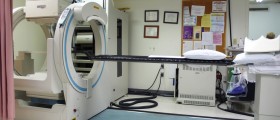
Squamous cell carcinoma is a type of skin carcinoma. It is actually the second most common skin carcinoma after basal cell carcinoma. Squamous cell carcinoma accounts for approximately 20% of all skin cancers diagnosed each year in the United States. The major contributor to this malignant disease is excessive exposure to harmful ultraviolet rays. The risk is increased in fair skinned people, particularly those with blond or red hair and blue/ green eyes. The risk is also significant if there is a history of indoor tanning and family history of skin cancers. This skin cancer also occurs more in people suffering from actinic keratosis, those with weakened immune system and those who have undergone radiation therapy. And finally, previous exposure to coal tar products and arsenic represent two more risk factors for squamous cell carcinoma.
Presentation of Squamous Cell Carcinoma
Initially, the tumor is in a form of a red, crusted or scaly patch. It can be also in a form of non-healing ulcer or firm red nodule. Squamous cell carcinoma predominantly affects sun-exposed areas. This is why it most commonly occurs on the head, neck, ears, trunk and arms. However, it can also occur on other parts of the body. The tumor may occur de novo or develop from a precancerous skin lesion called actinic keratosis.
If diagnosed in early stage of the disease squamous cell carcinoma is curable. Once the disease has progressed there is a higher chance the tumor cells have spread to regional lymph nodes or even distant organs.
Diagnosis and Treatment for Squamous Cell Carcinoma
Diagnosis is confirmed after pathohistological examination of the biopted or resected tumor. Once the diagnosis has been confirmed the patient can start with the treatment. It includes both, surgery and non-surgical treatment modalities. The doctor chooses the most suitable treatment modality.
Surgical procedures for squamous cell carcinoma include simple surgical excision, mohs micrographic surgery, electrodesiccation and curettage or cryosurgery. The goal of the surgery is to resect the entire tumor together with surrounding tissue. This is important since tumor cells may even in an early stage of the diseases spread to the surrounding skin. Furthermore, if there are signs that regional lymph nodes may be affected with the tumor or this has been confirmed by CT scan and MRI or if enlarged regional lymph nodes have been confirmed positive (affected by the tumor) with biopsy they must be resected as well.
After the surgery some patents must undergo radiation therapy. The goal of this treatment modality is to sterilize the operated area and kill the remaining tumor cells.

















Your thoughts on this
Loading...